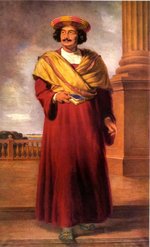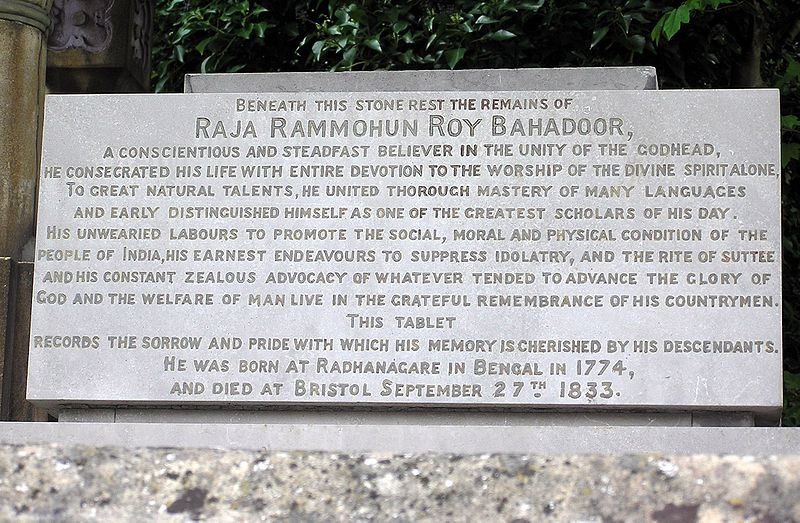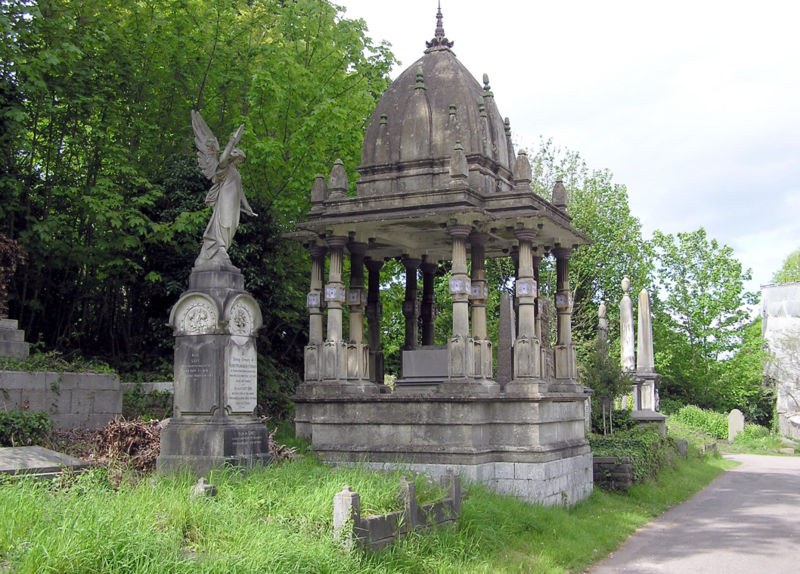<Back to Index>
- Explorer Marc Joseph Marion du Fresne, 1724
- Novelist Arthur Ignatius Conan Doyle, 1859
- Social Reformer Raja Ram Mohan Roy, 1772
PAGE SPONSOR

Raja Ram Mohan Roy (22 May 1772 – 27 September 1833) was an Indian religious, social, and educational reformer who challenged traditional Hindu culture and indicated the lines of progress for Indian society under British rule. He is sometimes called the father of modern India. He founded, along with Dwarkanath Tagore and other Bengalis, of the Brahmo Sabha in 1828, which engendered the Brahmo Samaj, an influential Indian socio-religious reform movement during the Bengal Renaissance. His influence was apparent in the fields of politics, public administration, and education, as well as religion. He was known for his efforts to abolish the practice of sati, the Hindu funeral practice in which the widow was compelled to sacrifice herself on her husband's funeral pyre.
Roy was born in Radhanagore, Bengal, in August 1774 or May 22, 1774, into the Rarhi Brahmin caste. His family background displayed religious diversity; his father Ramkanto Roy was a Vaishnavite, while his mother Tarinidevi was from a Shivaite family. This was unusual for Vaishanavites did not commonly marry Shaivites at that time. Thus, one parent wanted him to be a scholar, a sastrin, while the other wanted him to have a career dedicated to the laukik, which was secular public administration. He wandered around Himalayas and went to Tibet.
Ram Mohan Roy's impact on modern Indian history concerned a revival of the ethics principles of the Vedanta school of philosophy as found in the Upanishads. He preached about the unity of God, made early translations of Vedic scriptures into English, co-founded the Calcutta Unitarian Society, founded the Brahmo Samaj, and campaigned against sati. He sought to integrate Western culture with features of his own country's traditions. He established schools to modernize a system of education in India.
During these overlapping periods, Ram Mohan Roy acted as a political agitator and agent, whilst being employed by the East India Company and simultaneously pursuing his vocation as a Pandit.
In 1792, the British Baptist shoemaker William Carey published his missionary tract "An Enquiry of the Obligations of Christians to Use Means for the Conversion of Heathens. In the following year, William Carey landed in India to settle. His objective was to translate, publish and distribute the Bible in Indian languages and propagate Christianity to the Indian peoples. He realized the "mobile" (i.e. service classes) Brahmins and Pundits were most able to help him in this endeavor, and he began gathering them. He learned the Buddhist and Jain religious works as a means to improve his argument in promotion for Christianity in the cultural context. In 1795, Carey made contact with a Sanskrit scholar, the Tantric Hariharananda Vidyabagish, who later introduced him to Ram Mohan Roy; Roy wished to learn English.
Between 1796 and 1797 the trio of Carey, Vidyavagish and Roy fabricated a spurious religious work known as the "Maha Nirvana Tantra" (or "Book of the Great Liberation") and attempted to portray it as an ancient religious text to "the One True God", which was actually the Holy Spirit of Christianity masquerading as Brahma. The document's judicial sections were used in the law courts of the English Settlement in Bengal as Hindu Law for adjudicating upon property disputes of the zamindari. However, British magistrates and collectors began to suspect it as a forgery; its usage, as well as the reliance on pundits as sources of Hindu Law, was quickly deprecated. Vidyavagish has a brief falling out with Carey and separated from the group but maintained ties to Ram Mohan Roy. The Maha Nirvana Tantra's significance for Brahmoism lay in the wealth that accumulated to Rammohan Roy and Dwarkanath Tagore by its judicial use, and not due to any religious wisdom within.
In 1799, Carey was joined by missionary Joshua Marshman and the printer William Ward at the Danish settlement of Serampore.
From 1803 till 1815, Rammohan served the East India Company's "Writing Service", commencing as private clerk "munshi" to Thomas Woodforde, Registrar of the Appellate Court at Murshidabad, whose distant nephew, also a Magistrate, later made a living off the spurious Maha Nirvana Tantra under the pseudonym Arthur Avalon. In 1815, Raja Ram Mohan Roy formed Atmiya Sabha. Atmiya Sabha tried to initiate social and religious reforms in the society. Raja Ram Mohan Roy campaigned for rights for women, including the right for widows to remarry, and the right for women to hold property. He actively opposed Sati system and the practice of polygamy.
Roy resigned from Woodforde's service due to allegations of corruption. Later, he secured employment with John Digby, a company collector, and Rammohan spent many years at Rangpur and elsewhere with Digby, where he renewed his contacts with Hariharananda. William Carey had, by this time, settled at Serampore and the trio renewed their association with one another. William Carey was also aligned with the English Company, then headquartered at Fort William, and his religious and political ambitions were increasingly intertwined.
The East India Company was taking money from India at a rate of three million pounds a year in 1838. Ram Mohan Roy estimated how much money was being driven out of India and where it was headed towards. He predicted that around half of the total revenue collected in India was sent out to England, leaving India to fill taxes with the remaining money.
At the turn of the 19th century, the Muslims, although considerably decreased after the battles of Plassey and Buxar, still posed a political threat to the Company. Rammohan was now chosen by Carey to be the agitator among them. Under Carey's secret tutelage in the next two decades, Rammohan launched his attack against the bastions of Hinduism of Bengal, namely his own Kulin Brahmin priestly clan (then in control of the many temples of Bengal) and their priestly excesses. The social and theological issues Carey chose for Rammohan were calculated to weaken the hold of the dominant Kulin class, especially their younger disinherited sons forced into service who constituted the mobile gentry or "bhadralok" of Bengal, from the Mughal zamindari system and align them to their new overlords of Company. The Kulin excesses targeted included child marriage and dowry. In fact, Carey tried to convert Raja to Christianity and appointed a religious priest to try convert Raja, although the priest later accepted Hinduism.
Commenting on his published works, Sivanath Sastri wrote that Roy was part of a second appeal to the Christian Public. Brahmanical Magazine Parts I, II and III, with Bengali translation and a new Bengali newspaper called Sambad Kaumudi, was processed in 1821. In 1822, A Persian paper called Mirat-ul-Akbar contained
a tract entitled "Brief Remarks on Ancient Female Rights"; a book in
Bengali called Answers to Four Questions was released the same year.
The third and final appeal to the Christian public took place in 1823.
Roy wrote a letter to Rev. H. Ware on the "Prospects of Christianity in
India" and an "Appeal for Famine - Smitten Natives in Southern India"
in 1824. A Bengali tract on the qualifications of a God loving
householder, a tract in Bengali on acontroversy with a Kayastha, and a Grammar of
the Bengali language in English were written in 1826. A Sanskrit tract
on "Divine Worship by Gayatri" with an English translation, the edition
of a Sanskrit treatise against
caste, and the previously noticed tract called "Answer of a Hindu to
the Question" was released in 1827. A form of divine worship and a
collection of hymns were composed by Roy and his friends in 1828. In 1829, "Religious Instructions founded on Sacred Authorities" was published in English and Sanskrit;
a Bengali tract called "Anusthan" was also published that year. A
petition against Suttee also took place in 1829. In 1830, Roy was in
charge of a Bengali tract, a Bengali book concerning the Bengali
language, the trust deed of the Brahmo Samaj, an address to Lord William Bentinck congratulating
him for the abolition of Sati, a document in English of the arguments
regarding the burning of widows, and a tract in English on the disposal
of ancestral property by Hindus. In 1830, Ram Mohan Roy travelled to the United Kingdom as an ambassador of the Mughal emperor Akbar II,
who conferred him title of Raja to convince British government for
welfare of India and to ensure that the Lord Bentick's regulation
banning the practice of Sati was not overturned. Roy also visited France. Roy died at Stapleton, which was then a village to the north east of Bristol but currently a suburb, on September 27, 1833. His cause of death was meningitis; he was buried in Arnos Vale Cemetery in southern Bristol.
Ram
Mohan Roy was married three times. His first wife died during his
childhood. His second wife, who died in 1824, bore him two sons:
Radhaprasad in 1800 and Ramaprasad in 1812. Roy's third wife, Uma Devi,
outlived him.
The religious reforms of Roy contained in beliefs of the Brahmo Samaj expounded by Rajnarayan Basu are: Brahmos believe that the fundamental doctrines of Brahmoismare
at the basis of every religion, followed by man; Brahmos believe in the
existence of One Supreme God, and worship Him alone. Brahmos believe
that worship of Him needs no fixed place or time. Roy demanded property inheritance rights for women and, in 1828, set up the Brahmo Sabha, which was a movement of reformist Bengalis formed to fight against social evils. Roy's
political background influenced his social and religious to reforms of
Hinduism. He wrote: "The present system of Hindoos is not well
calculated to promote their political interests…. It is necessary that
some change should take place in their religion, at least for the sake
of their political advantage and social comfort." Rammohan
Roy's experience working with the British government taught him that
Hindu traditions were often not respected or thought as credible by
Western standards; this affected his religious reforms. He wanted to legitimize Hindu traditions to his European acquaintances by proving that "superstitious practices which deform the Hindoo religion have nothing to do with the pure spirit of its dictates! [sic]" The "superstitious practices" Rammohun Roy objected included sati, caste rigidity, polygamy and child marriages. These practices were often the reasons British officials claimed moral superiority over the Indian nation. Ram Mohan Roy's ideas of religion sought to create a fair and just society by implementing humanitarian practices similar to Christian ideals and thus legitimize Hinduism in the modern world.
Roy believed education to be an implement for social reform. In 1817, in collaboration with David Hare, he set up the Hindu College at Calcutta. In 1822, Roy founded the Anglo - Hindu school, followed four years later by the Vedanta College, where he insisted that his teachings of monotheistic doctrines be
incorporated with "modern, western curriculum"; Vedanta College offered
courses as a synthesis of Western and Indian learning. In 1830, he helped Alexander Duff in establishing the General Assembly's Institution, by providing him the venue vacated by Brahma Sabha and
getting the first batch of students. Roy supported induction of western
learning into Indian education. He advocated the study of English, Science, Western Medicine and Technology. He spent his money on a college to promote these studies. Roy published magazines in
English, Hindi, Persian, and Bengali. He published Brahmonical Magazine
in English in 1821. One notable magazine of his was the Sambad Kaumudi,
published in 1821. In 1822, Ram Mohan published Mirat-ul-Akbar in
Persian language. Brahmonical Magazine ceased to exist after the
publication of a few issues.
But Sambad Kaumudi, a news weekly, covered topics such as freedom of
press, induction of Indians into high ranks of service and separation
of the executive and judiciary. Sambad Kaumudi became bi-weekly in
January 1830 and continued for 33 years. He
published newspaper to register his protest against the introduction of
Press Ordinance of 1823. The ordinance stated that a license from the
Governor General in council would be mandatory to publish any
newspaper. When the English Company censored the press, Rammohan
composed two memorials against this in 1829 and 1830 respectively.
Being an activist, he steadily opposed social atrocities like Sati and child marriage. The tomb was built by Dwarkanath Tagore in 1843, 10 years after Rammohan Roy's death in Bristol on Sep 27, 1833; the tomb is located in the Arnos Vale Cemetery on
the outskirts of Bristol. In 1845, Dwarkanath Tagore arranged for
Rammohan's remains to be removed and returned to India through Roy's
nephew, who had accompanied Dwarkanath for this purpose to Britain.
Rammohan's relics were cremated near Kolkata on February 28, 1846 by
his family.

